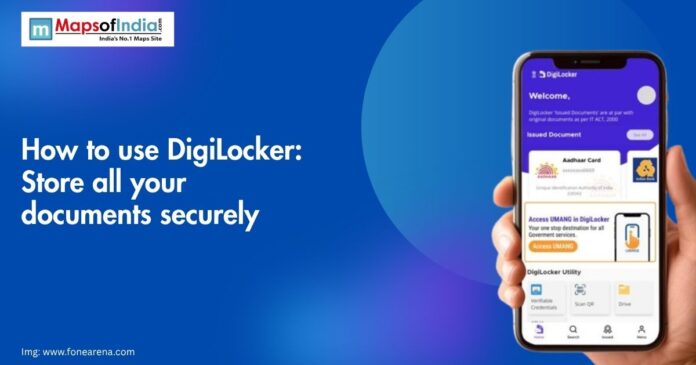DigiLocker is the most important initiative of India’s Digital India program. Launched by the Ministry of Electronics and Information Technology (MeitY). It aims to provide paperless governance to citizens. It is a secure cloud based platform for storing data. We can share our data and verify digital documents. Citizens can access their authentic documents like Aadhaar, PAN cards, driving licenses, and educational certificates anytime and anywhere. This initiative was launched in 2015. DigiLocker has 43.49 crore users as of December 2024. It has facilitated 9.4 billion document issuances. The platform reduces the need for physical documents which minimises the risk of loss or damage. It uses Aadhaar based authentication and encryption for security.
DigiLocker overview
DigiLocker was developed by the Ministry of Electronics and Information Technology (MeitY). It was launched under the Digital India program in 2015. It aims to transform India into a digitally empowered nation. Prime Minister Narendra Modi inaugurated it on July 1, 2015. The main goal of launching Digilocker was to adopt paperless governance. MeitY sought to reduce administrative costs and delays. Physical documents risked loss and forgery. DigiLocker ensures authenticity via Aadhaar integration. It was designed to empower citizens with secure and anytime access to documents. India’s e-Governance Division oversees its work. The platform aligns with India’s vision of a knowledge economy. It supports e-governance by streamlining document verification. MeitY collaborated with UIDAI for Aadhaar based security. The initiative targets urban and rural citizens. bridging the digital divide present in the country.
How DigiLocker Works
DigiLocker is a user-friendly application. At the beginning users sign up using their Aadhaar number or mobile number. An OTP for verification is sent to aadhar linked mobile number. After verification, users enter their basic information. After registration, users create a username and a six-digit PIN. The application platform offers 1 GB of storage for uploaded documents. Users get to access two sections which are Issued Documents and Uploaded Documents. Issued Documents include digital copies from government agencies. like e-Aadhaar or PAN fetched via URIs. Uploaded Documents allow users to upload files in PDF, JPG, PNG, or TIFF formats. up to 10 MB. Documents can be digitally signed using the integrated e-Sign service. Users share documents via email or WhatsApp by generating a link. Government agencies and requesters verify documents instantly. The app is available on Android, iOS and the web at digilocker.gov.in.
Impact on Indian Daily Life
DigiLocker simplifies daily tasks for Indians. It eliminates carrying physical documents. Students use it for academic certificates during college admissions. Professionals share KYC documents for banking. Drivers use it during traffic checks. Over 43 crore users access documents on smartphones. In the year 2023, DigiLocker saved 6 crore man hours in government processes. It integrates with services like Passport Seva and the Income Tax Department. Rural users in Uttar Pradesh access land records digitally. Health records linked to Ayushman Bharat Health Accounts (ABHA) are stored securely. Citizens save time and effort. Bureaucratic processes are faster. Government offices see reduced paperwork in offices. DigiLocker empowers citizens with instant access to verified documents.
Pros of DigiLocker
DigiLocker offers multiple benefits. It reduces physical paperwork. Documents are safe from loss or damage. The platform uses 256-bit SSL encryption for security. Aadhaar based authentication ensures only authorised access. Documents are legally valid as per the Information Technology Act, 2000. Airports and railways accept digital IDs. Users save time with instant document sharing. Government agencies verify documents in seconds using this application. The e-Sign feature simplifies attestations. It supports over 210 document types. which includes passports and mark sheets. Free 1 GB storage meets most needs and is sufficient to store necessary documents. Integration with 28 states and 8 union territories enhances accessibility. It promotes paperless governance and saves resources. This application is helpful for both urban and Rural users to access records without travelling. DigiLocker fosters digital empowerment across India.
Cons of DigiLocker
With all these pros, DigiLocker has some limitations. Internet access is mandatory to use this. Rural areas with poor connectivity face issues of accessibility. Only 66% of India has a reliable internet connection. Sometimes technical glitches occur. Users report app crashes during updates. The verification process can freeze. Some government departments are not fully integrated. Like in certain states land records are unavailable. File size limits of 10 MB restrict large documents. Non-Aadhaar users face registration challenges. NRIs cannot use foreign numbers. Security concerns persist despite encryption. Data breaches are the biggest worry for users. The platform’s interface is kind of confusing. Sometimes it can confuse less tech known users. Elderly citizens in cities struggle with navigation on the platform. On the other hand awareness is low in smaller towns. These issues hinder universal adoption.
Evolution of DigiLocker Since 2015
DigiLocker started as a beta in February 2015. It had 100 MB of storage initially. By July 2016, it recorded 2.013 million users and 2.413 million documents. Storage was increased to 1 GB in 2017. The Information Technology Rules in 2016. Made digital documents legally equivalent to physical ones. In 2019 Digilocker was integrated with Passport Seva enabling e-passport access. By the year 2020 the toilet users were 101.29 million users. The platform issued 4.94 billion documents by 2023. In 2023 the health record integration with ABHA was added. Till December 2024 it has 43.49 crore users and 9.4 billion documents are issued. Over 43 requester organisations which include banks and universities have accepted DigiLocker documents. The app now supports digital signing and nominee addition. It has evolved into a comprehensive digital wallet which helps to enhance digital governance.
Conclusion
DigiLocker is a game changer for India’s digital dream. It made document management simple for millions. Users access verified documents instantly which saves time. Its secure cloud platform protects sensitive data. Integration with government services streamlines processes. Big cities have seen faster KYC and admissions. Rural areas benefit from digital access to records. But there are still some problems like connectivity issues and technical glitches that pose challenges. Awareness and usability need improvement. Ministries vision of paperless governance is advancing. With 43.49 crore users. DigiLocker is a cornerstone of Digital India. Broader integration and better rural access will strengthen its impact. It empowers citizens. Reduces paperwork and fosters a digital economy. Collaboration between the government, citizens, and agencies will ensure its success. DigiLocker is a vital step toward a digitally empowered India.




